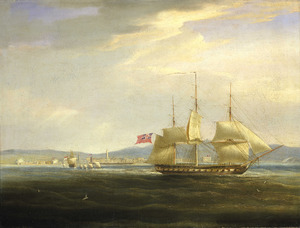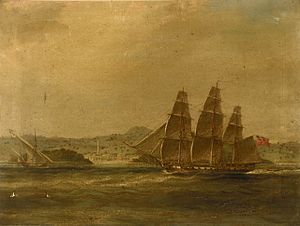HMS Mercury (1779) facts for kids

HMS Mercury cutting out a French gunboat from Rovigno, 1 April 1809
|
|
Quick facts for kids History |
|
|---|---|
| Name | HMS Mercury |
| Ordered | 22 January 1778 |
| Builder | Peter Everitt Mestaer, King and Queen Shipyard, Rotherhithe |
| Laid down | 25 March 1778 |
| Launched | 9 December 1779 |
| Completed | By 24 February 1780 |
| Fate | Broken up in January 1814 |
| General characteristics | |
| Class and type | 28-gun Enterprise-class sixth-rate frigate |
| Tons burthen | 60512⁄94 (bm) |
| Length |
|
| Beam | 33 ft 9 in (10.3 m) |
| Depth of hold | 11 ft 0+1⁄2 in (3.4 m) |
| Sail plan | Full-rigged ship |
| Complement | 200 |
| Armament |
|
HMS Mercury was a fast 28-gun British warship called a frigate. She was built for the Royal Navy during the American War of Independence. This ship had an exciting career, serving in many conflicts, including the French Revolutionary Wars and the Napoleonic Wars, before she was taken apart in 1814.
Contents
Building a Warship: HMS Mercury
How HMS Mercury Was Built
Mercury was ordered on January 22, 1778. She was built at the King and Queen Shipyard in Rotherhithe, near the River Thames. Her construction started on March 25, 1778.
When HMS Mercury Was Ready
The ship was launched into the water on December 9, 1779. She was fully ready for service by February 24, 1780. Building Mercury cost about £6,805. With all the extra work, like adding copper to her hull, the total cost was around £13,603.
Early Years: American War of Independence
First Missions and Captures
Mercury began her service in 1780. Her first captain was Isaac Prescott. In April 1780, she sailed to Newfoundland. On July 23, she returned from a patrol. She had successfully taken back a ship called Elizabeth. An American privateer had captured Elizabeth a few days earlier.
Joining Other Warships
In 1781, Mercury joined a group of ships led by George Johnstone. Captain William Carlyon took command in May 1781. He sailed Mercury to Hudson Bay. There, on May 17, they recaptured a small ship called HMS Sprightly. Later that year, Mercury and two other British ships, HMS Rattlesnake and HMS Jupiter, captured a French ship named Philippine.
More Captures and New Commanders
In March 1782, Mercury and Jupiter captured a French privateer named Bologne. A privateer was a private ship allowed by a government to attack enemy ships. Captain Henry Edwyn Stanhope became her commander in September 1782. Mercury was then taken out of service for a short time.
A Visit to America
She was back in service in April 1783, still under Captain Stanhope. In June, she sailed to Nova Scotia. In 1785, Mercury was allowed to escort a merchant ship to Boston in America. This was a big deal because it was the first time a British warship had visited Boston freely since 1776.
Repairs and Mediterranean Duty
Mercury was taken out of service again in July 1786. She had some repairs done between 1787 and 1788. In May 1788, Captain Augustus Montgomery took command. She then sailed to the Mediterranean Sea. She returned to Britain and was taken out of service in 1790.
French Revolutionary Wars: Action and Prizes
Back in Service
Mercury was not used right away when the war with France started. But after some work at Portsmouth, she was back in action in early 1796. Captain George Byng was her commander. Later, in April 1797, Captain Thomas Rogers took over.
Capturing Privateers
While serving near Lisbon, Portugal, Captain Rogers captured three French privateers. These were Benjamin on January 5, 1798, Trois Sœurs on January 15, 1798, and Constance on January 25, 1798. Capturing privateers was important because they attacked British merchant ships.
- Benjamin was a new ship with 16 guns and 132 crew members. Mercury chased her for 36 hours before capturing her.
- Trois Sœurs was a brig (a type of ship) with 16 guns. Mercury chased her for eight hours.
- Constance had 12 guns and 96 crew. Mercury captured her after a five-hour chase.
More Captures and Convoy Attacks
In June 1798, Mercury went back to Newfoundland. In 1799, she captured two more ships, San Joce and Hosprung.
On January 24, 1800, Mercury recaptured the ship Aimwell. A French privateer had taken Aimwell while she was sailing from Quebec to London. On March 29, Mercury helped capture a French warship named HMS Courageux.
Capturing the Égyptienne
On February 5, 1800, Mercury captured the French privateer brig Égyptienne near the Isle of Wight. Égyptienne had 15 brass guns and 66 men. Her crew fired at Mercury as they surrendered, slightly wounding one British sailor.
Mediterranean Operations
After spending some time in the English Channel, Mercury sailed to the Mediterranean in May 1800. She joined a squadron of ships off Cadiz and later arrived in Alexandria, Egypt.
On January 5, 1801, Mercury captured a French small sailing vessel. The next day, Mercury had a big success. Her boats captured 15 ships from a convoy of 20 vessels. The convoy was sailing from Cette to Marseilles. The French gunboats guarding the convoy ran away, so Mercury had no injuries.
Capturing a French Corvette
On January 20, 1801, Mercury captured the French warship Sans Pareille. This was after a nine-hour chase. Sans Pareille was a French navy ship with 18 guns. She only had 15 crew members, so she could not fight back. She was carrying supplies for the French army in Egypt. The British Navy later used Sans Pareille as HMS Delight.
Attempt to Recapture HMS Bulldog
On May 25, 1801, Mercury tried to recapture the British bomb vessel HMS Bulldog at Ancona. A small group of sailors managed to get Bulldog out of the harbor. But the wind stopped, and enemy boats arrived. The British sailors were outnumbered and tired, so they had to leave Bulldog behind. Mercury lost two men and had four wounded in this attempt.
Destroying a Pirate Ship
On June 23, 1801, boats from Mercury and HMS Corso destroyed a pirate ship called Tigre. Tigre had eight guns and 60 crew members. British marines landed and captured some pirates. The sailors brought Tigre out, along with goods she had stolen.
Second Attempt on HMS Bulldog
A second attempt to recapture Bulldog was successful on September 16, 1801. Mercury worked with HMS Champion and HMS Santa Dorothea. They found Bulldog escorting four smaller ships carrying cannons and supplies. Champion got close to Bulldog, which surrendered after being fired upon. Mercury captured one of the supply ships.
Napoleonic Wars: More Battles and End of Service
Floating Battery and New Captains
In May 1803, Mercury was changed into a floating battery at Deptford. This meant she was used more like a floating fort. Captain Duncombe Pleydell-Bouverie took command. She then operated against Spanish ships. On February 4, 1805, she captured a Spanish gun-vessel called Fuerte de Gibraltar.
Captain Charles Pelly took over in August 1805. Mercury returned to Newfoundland in May 1806.
Action in the Adriatic Sea
In June 1807, James Alexander Gordon became commander. He sailed Mercury to the Mediterranean. In April 2008, Mercury, along with HMS Alceste and HMS Grasshopper, attacked a Spanish convoy. They destroyed two escort ships and captured seven merchant vessels.
In November 1808, Henry Duncan took command. He took Mercury into the Adriatic Sea for more battles. On December 30, Mercury and Alceste captured two ships, Hereux and Spirito Santo.
Attacks on Coastal Towns
Mercury was involved in attacks at Pesaro on April 23 and Cesenatico on May 2. At Pesaro, the British ships bombarded the town and captured 13 small coastal vessels. They had no casualties. At Cesenatico, Mercury ran aground but was able to keep firing her guns. The British captured 12 vessels and spiked two enemy guns.
In June, Mercury sent her boats to destroy several ships on the beach at Rotti.
On September 7, Mercury captured the French schooner Pugliese from Barletta. Pugliese had seven guns and 37 men. British boats, led by Lieutenant Pall, captured the ship even though it was protected by other armed boats and a castle. The British had no injuries. This was Mercury's last battle before she was taken out of service in early 1810.
Troopship Duty
Mercury was then changed into a troopship in mid-1810. This meant she was used to carry soldiers. Lieutenant William Webb was her commander. Commander John Tancock took over later in 1810. Mercury spent most of 1811 near Lisbon. Commander Clement Milward took command in November 1811 and sailed to the Leeward Islands. Her last commander was Sir John Charles Richardson.
On July 29, 1813, Mercury helped capture the American ship Fame. Fame was a whaling ship returning from the Pacific with a cargo of sperm oil.
The End of HMS Mercury
Mercury was finally taken apart at Woolwich in January 1814.
Images for kids




